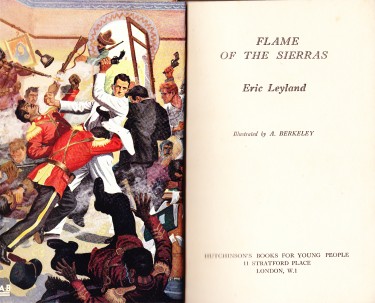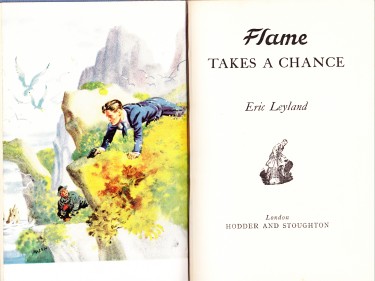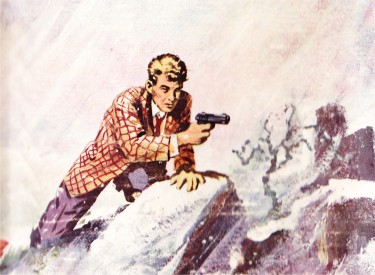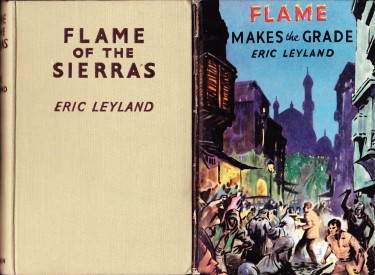1.Amazon
Adventure
2.South Sea Adventure
3.Underwater Adventure
4.Volcano Adventure
5.Whale Adventure
6.African Adventure
7.Elephant Adventure
8.Safari Adventure
9.Lion Adventure |
10.Gorilla
Adventure
11.Diving Adventure
12.Cannibal Adventure
13.Tiger Adventure
14.Arctic AdventureAutobiography,
My Own Life of Adventure,
published in 1982.
|
Capt W E Johns' publisher in the late 1950s,
namely H&S (except where noted), published a series
similar to Biggles, namely FLAME, by well-known but
now mostly forgotten children's author, Eric
Leyland. None are exceptionally collectable
as few people collect the series.
Flame,
Secret Agent 1958
Flame and the King's Ransom 1955
Flame and the League of Fire 1959
Flame hits Back 1954
Flame hits the Trail 1954
Flame makes the Grade 1957
Flame of the Amazon 1952
Flame of the Sahara 1955
Flame of the Sierras
(Hutchinson's Books for Young People) 1949 |
Flame on
the Treasure Trail 1956
Flame over Africa 1951
Flame sets the Pace 1956
Flame takes a Chance1953
Flame takes Command 1957
Flame takes Over 1950
Flame wins Through 1953 |
Flame of the Sierras
This, the first in the series, was published
by Hutchinson as part of their 'Books for Young People'
series in 1949. The stunning coloured frontispiece and
illustrations throughout the book were done by A
Berkeley. I don't have the dust jacket but you can find
online scans. At 216pp this is a long story and probably
the longest in the series. The paper quality and printing
was far superior to that of the H&S titles which
followed. The latter's frontispieces reproduced the front
covers of the dust jackets.
 |
 |
The unique and first of the
'Flame' novels
|
Frontispiece a repeat of the
dust jacket on H&S novels
|
 |
 |
| David Flame in action! |
From plain cloth to gloss
laminated covers |
David Flame at the beginning of
this story is 27 years of age and a railway engineer. His
Uncle George Manners of the British civil service is 45
though he tends to come across as someone in his late
50s. The two though close are opposites. David: thickset,
brown of complexion and humorous; George: serious, formal
and wrapped up in formulating Foreign Policy for His
Majesty's government. David is in London to interview a
prospective new employee, Tony Carstairs, a lad who
attended (and was expelled from) David's old school,
Frale. Barely 18, "...his grey eyes held humour, but
David was conscious of something else, something
deeper." Feline fans will not take to Tony as the
lad was expelled for firing a B.S.A. .22, killing a cat
and narrowly missing a housemaster!
The third member of Flame's trio is Ginger
Johnston, "... his red hair aflame," and
"... a dour, taciturn man of 35, his face tanned to
the colour of old leather, his flesh crinkled from
exposure to sun and wind, and his body toughened by
adventures in almost every country of the world. His
short, stubby body was like iron... "
The story in short follows the trio's
adventures in a mysterious Southern American country as
they become involved in the overthrow of a military
dictatorship. To explore the plot more would take away
the pleasure of reading this story. The content certainly
isn't suitable for children of today and at certain
points one wonders if the author really had intended the
book for an adult audience with its violence and non-PC
overtones. Despite this, it's extremely readable,
entertaining, humorous and full of action with a variety
of plot twists and interesting characters. The charming
line drawings certainly add to the flavour. [JT 8.01]
Article by
Steve Holland of Story Paper Index
What was the magic of Dan Dare? It's
difficult to tell retrospectively, but it seems that he
was the hero in the right place at the right time. The
1940s had seen huge leaps in the science of rocketry and
man's ability to split the atom had been terrifyingly
proved in Japan in 1945. The end of the war (the one
hoped to end all wars) was the beginning of an uphill
struggle to rebuild life throughout Europe, the echo of
which continued through the 1950s and really only have
such a profound impact in the early 1960s and the baby
boomer era.
During the late 1940s -- nick-named the Age
of Austerity -- life was not easy. Everything was still
on the ration and many factors combined to make life a
little drab. Taking just one tiny slice of this, we had a
ban on importing children's cartoons, so you could not
even see Mickey Mouse at the cinema if you were a kid
despite the fact that he had his own comic (Mickey Mouse
Weekly). Instead, you had home-grown cartoons created by
ex-Disney director David Hand (Animaland being the most
famous of his series); there were dozens of black and
white films shot in the UK to fill the gap left by
Hollywood, and it was impossible to import those
colourful comic books that had started up just before the
war; we had our own, but they were poor by comparison.
Around the turn of the decade, things
started to brighten up: it was a new decade for starters,
a chance to put the war behind you. Food and clothing
rations became a little less strict. You could get real
eggs, not just the powdered variety. People wanted things
to be brighter and more colourful.
Teenage delinquency was a big problem in the
late 1940s. Some people (one being the Rev. Marcus
Morris) pointed to comics and story papers as a source of
delinquent ideas. The book market was flooded with the
likes of tough crime writers Hank Janson and Ben Sarto,
and copies were passed around under desks -- often with
the sexy covers torn off -- for all schoolboys to thrill
at.
Enter the Eagle. Bright, colourful, edited
by a man of the cloth. Expensive compared to other
papers, but the first issue was a sturdy 20 pages (only
16 in #2 which was to become its normal size except when
advertising pushed it back up to 20). Parents are trying
to put the past behind them, looking to the future -- and
there's Dan Dare, pilot of the future, in a 'future' that
was built strictly along the lines of the R.A.F. (by
1950, books about the war were just beginning to appear,
including accounts of those brave fighter pilots who
fought the Battle of Britain). Eagle was heavily
advertised by Hultons, who gave away tens of thousands of
copies at schools, via a newsagents token campaign, and
from cars that cruised through many large cities with a
huge eagle mounted on the roof.
Nearly a million children spent the week
wondering what would happen to the spaceship just
launched for Venus at the end of episode one. I doubt if
any of them had ever quite dreamed of this kind of
adventure in such vivid colour. Add to this the fact that
the paper also carried bible stories in picture strip
form on the rear, which would have been another plus
point to wary parents, although the children would
probably be more excited by seeing their radio hero P.C.
49 in strip form. The Eagle from the start was attractive
to all ages: an exciting weekly as far as its readers
went but with a wide-ranging educational bias to attract
parents.
It was in the right place at the right time.
#
THE SERIES
1. Mission to Mars (1955)
2. The Domes of Mars (1956)
3. The Voices of Mars (1957)
4. Peril on Mars (1958)
5. Raiders on Mars (1959)
Review by Jim Mackenzie
Nothing dates more than technology. Nothing
is more dangerous than making predictions about the
future. No one looks a bigger fool than the writer who
gets it wrong. Patrick Moore has always been scathing
about those who don't know the difference between
astronomy and astrology. However, back in 1955, he took
the risk of looking a fool himself by peering into his
own crystal ball and constructing a series about the
possibilities of space exploration and even space
colonisation. He wrote five books about the planet Mars
and man's attempt to reach, explore and then live on the
red planet.
This is the first in the series, his first
toe in the water, so to speak. So, how well does he cope
? The first point to make is that he is not to be
underestimated as a storyteller. The plot is well-shaped,
the characters briefly and effectively sketched in, and
moments of real tension are created at frequent
intervals. To link with his potential juvenile audience
Moore tells the story from the point of view of sixteen
year old Maurice Gray who has been sent out to Woomera,
Australia, after the death of his parents in an air
disaster. Whilst there, he discovers that the uncle he
was to stay with has mysteriously disappeared. Where on
earth can he be ? Well, exactly, he's not on earth
–he's on Mars. In fact he is trapped on Mars with
the two other members of the first expedition in the
space-ship, Hermes. So, with a confident acceleration of
the plot, Moore plunges his young hero straight into the
action of a rescue mission. Maurice's qualifications for
the journey are his low body weight and his ability to
read Morse Code.
For a man who knows so much, Moore keeps the
technical details to a minimum. His description of the
effect of gravity and then later of weightlessness during
and after blast-off is like the perfect blue-print for
all other writers in the genre. A space walk which goes
wrong is hauntingly reminiscent of the best moments of
the BBC radio series "Journey into Space" which
terrified its young listeners before the whole experience
became hackneyed. From the desert of Woomera to the red
dust desert of Mars seems perfectly possible. Crashing
through the mysterious Violet Layer, the rescue craft
Ares becomes a casualty itself, its radar destroyed. Even
if Maurice and his companions can find the missing
astronauts and blast back through the dangerous
atmosphere of the red planet, their destiny would be to
wander endlessly in space on a voyage to infinity.
All the details about Phobos and Deimos, the
little Martian moons, the length of the Martian day and
nights, the temperatures to be expected, the reduced
effects of gravity, the amount of oxygen needed to
complete a ninety mile journey, seem perfectly plausible.
However, the crunch moment eventually arrives and Moore
has to answer the inevitable question – Is there
life on Mars? You wouldn't expect this reviewer to give
away all the details but the answer is a qualified yes.
Strange creatures, repulsive creatures, unexplained
creatures are presented to the reader as they become yet
another hazard on the terrible journey across the desert
wastes.
Patrick Moore would have to admit that this
is all fiction nowadays but it doesn't really matter. The
fact is that he has told a
good story but also left enough unexplored for the reader
to agree with Maurice when he says,
"in spite of all its unfriendliness and all its
perils Mars still held a queer fascination for him, so
that one day he must return."
Everyone is now ready for the next in the
series "The Domes of Mars". #
| ADVENTURE series
(and others), by Michael Dara Gibson |
Further
information on this series and author is required.
Published
by Brock; very similar to Enid Blyton's SECRET 7 series
in format.
Hundred
Mile Adventure
MICHAEL
GIBSON trained as an engineer before the war and worked
for a private charter company. He moved to technical
illustrating with a short stint as the production manager
of a publishing firm. His favourite interest was
bird-watching.
From Jim
Mackenzie: jmackenzie48@yahoo.com
Hello
John,
Another attempt to fathom the British Library records.
This time quite a few of the ones on your list do not
appear which shows how unreliable/reliable the British
Library can be. Of the ones mentioned below "The
Wreckers of Pengarth" is another one of those books
that crops up everywhere you go. I've never bought (or
read) it.
Tables
Turned. [A novel.] A. & C. Black 1939.
The Air Wreckers. Warne 1944.
Dangerous Mission. A boy's adventure story. Warne 1948.
Tatra Adventure. Warne 1948.
Mystery at Three Elms. Warne 1948.
The Wreckers of Pengarth. Collins 1949.
The House on the Marsh. Herbert Jenkins 1950.
Hundred Mile Adventure ... Illustrated by Bernard Wragg.
Brockhampton 1950
At the `White Wolf.'Warne 1954..
Mystery by Moonlight. Staples Press 1954.
Snow Valley Adventure. Ward, Lock & Co 1956.
Danger in Dynwich. Ward, Lock 1957
How Engines work and how to keep them working. Collins
1957.
Fly-away Johnny Hamish Hamilton 1958.
Ian Munro's Monte Carlo Rally. (Illustrations by Arthur
Horowicz.) Brockhampton 1958.
Midnight Rally ... Illustrations by George Lane. Hamish
Hamilton 1958.
Rescue from the Air ... Illustrated by Gordon Davies.
Abelard-Schuman:1960.
Le Mans 24 Hours. Illustrated by John Ross. Brockhampton
1962.
Frog march, etc. Brockhampton Press, 1969.
The rise of Japan. Wayland, 1972
Further information on this series and
author is required.
Published
by Brock; also very similar to Enid Blyton's SECRET 7
series in format. Illustrated by Lilian Buchanan.
1. The
Cherrys of River House 1952
2. The Cherrys and Company 1953
3. The Cherrys by the Sea 1954
4. The Cherrys and the Pringles 1955
5. The Cherrys and the Galleon 1956
6. The Cherrys and the Double Arrow 1957
7. The Cherrys on Indoor Island 1958 |
8. The
Cherrys on Zigzag Trail 1959
9. The Cherrys' Mystery Holiday 1960
10. The Cherrys and Silent Sam 1961
11. The Cherry's Famous Case 1962
12. The Cherrys to the Rescue 1963
13. The Cherrys in the Snow 1964
14. The Cherrys and the Blue Balloon 1965 |
WILL
SCOTT worked as a cartoonist, art critic, art
editor and drama critic before operating full time as an
author.
Other Books
Half-Term Trail ... Illustrated by Mary Willett. Blackie
1955.
The Great Expedition Illust C. Clixby Watson. Maps by
Henry West and others. University of London Press 1962. ARTHUR WATERHOUSEGY
Jim Mackenzie
“There
is trouble at Fellside Farm in the Lake District. This is
a grand open-air adventure full of exciting
characters.”
So runs
the publisher’s blurb for “Rogues of the
Fells” and it can apply equally fairly to the other
two books in the series. They were all written for 7 to
10 year olds and they all concern the same group of three
children and same small farm.
“The
farm where the Wains lived was just off one of the lonely
roads that wind in and out of the great hills in the Lake
District.”
“Raiders
of the Fells” (1948) tells of how Harry and Tess
Wain, together with their friend John Grayson, manage to
frustrate the activities of a gang of sheep rustlers. In
95 pages and 9 chapters they strive to round up the
thieves who tend rather foolishly to return to the scenes
of their crimes the night of every full moon.
“Rogues
of the Fells” (1951) contains another old favourite
device when writers for juveniles are in sheep country.
This is to develop the story of the renegade dog who has
become a sheep worrier. All children are torn between
wanting the sheep to be protected and the savage fact
that dogs who are normally portrayed as friendly
companions sometimes have to meet their fate at the
barrel of a farmer’s gun.
In some
ways “Fly of the Fells” (1957) is the most
effective of the three books. Eric Knight’s
“Lassie Come Home” with its story of a
dog’s incredible journey from Scotland to Yorkshire
is the most famous example of this genre. The story of
Fly’s disappearance draws upon some of the same
features which made that “Lassie” story so
appealing. The enduring love that the three children feel
for their canine companion and friend and the consequent
devastation they experience when Fly goes missing can be
taken for granted. After all Fly has proved his worth in
the previous two books. The episodic nature of Fly’s
own experiences as he wanders through a series of owners,
dazed and bewildered by his accident, allows the
narrative to move at a swift pace. The memory loss that
makes recognition difficult even when reunification takes
place, and the different names that Fly will now answer
to, all ensure a period of suspense before the happy
ending is cleverly drawn out.
Arthur
Waterhouse’s introduction to the Lake District is a
gentle one but one which is totally appropriate to his
very young readers.
Arthur
Waterhouse lived in the famous Lancashire coastal resort
of Blackpool and liked nothing better than to walk each
day on the promenade with his big Retriever dog. As well
as writing a large number of stories for children
Waterhouse took a keen interest in county cricket and was
always an avid spectator at the matches in Blackpool.
Amongst
his other stories published in the Brock series are
“Headlong into Adventure”, the story of a quiet
Cornish holiday that suddenly becomes a smuggling
adventure on both sides of the English Channel. There is
also “Rungate Manor” described in a dust-jacket
blurb as “A mystery which hums with adventure from
the moment Roy and Barbara get caught with a dud
half-crown…”, “Goldie of Goldstones”
which details “The story of Margery’s
retriever. Full of exciting adventure from poachers to
circuses.” Finally there is “Dark
Champion”, as the advertisement declares “this
is the story of the horse Connemara Jim, and how he
became famous.”
Raiders
of the Fells
Rogues of the Fells
Fly of the Fells
Headlong into Adventure
Rungate Manor
Goldie of Goldstones
Dark Champion
| Other
BROCKHAMPTON-published titles |
Three's a Crowd,
by
Michael Drin
|




